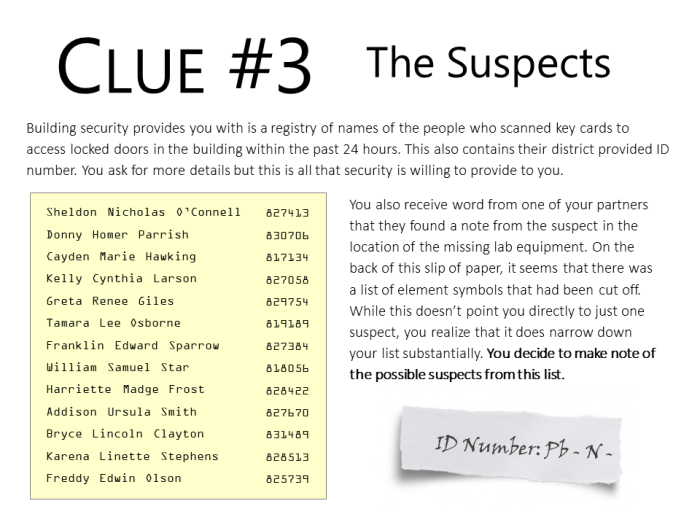Unveiling the captivating world of forensic chemistry, the stoichiometry murder mystery answer key takes center stage, presenting a thrilling narrative that intertwines the intricacies of chemical reactions with the enigmatic realm of murder investigations. Prepare to embark on an extraordinary journey where stoichiometry, the study of quantitative relationships in chemical reactions, becomes the key to unlocking the secrets of a puzzling crime.
As we delve into this captivating tale, we will witness how stoichiometric calculations illuminate the path towards identifying the culprit, unraveling the mysteries surrounding the victim’s demise. The precise ratios and proportions of reactants and products, governed by the fundamental principles of stoichiometry, hold the power to expose the truth and bring justice to light.
Stoichiometry: Stoichiometry Murder Mystery Answer Key
Stoichiometry is the branch of chemistry that involves the study of the quantitative relationships between reactants and products in chemical reactions. It helps us to predict the amount of reactants and products involved in a particular reaction and to determine the limiting reactant, which is the reactant that is completely consumed in the reaction.
A balanced chemical equation represents the stoichiometric proportions of the reactants and products in a chemical reaction. For example, the balanced chemical equation for the combustion of methane is:
CH₄ + 2O₂ → CO₂ + 2H₂O
This equation shows that one molecule of methane reacts with two molecules of oxygen to produce one molecule of carbon dioxide and two molecules of water.
Stoichiometry can be used to determine the limiting reactant in a reaction. The limiting reactant is the reactant that is completely consumed in the reaction, and it determines the maximum amount of product that can be formed. To determine the limiting reactant, we compare the mole ratios of the reactants to the stoichiometric coefficients in the balanced chemical equation.
Murder Mystery

In a murder mystery, stoichiometry can be used to determine the identity of the culprit. In one case, a victim was found dead in their apartment, and the police suspected that they had been poisoned. The police found a bottle of pills in the victim’s apartment, and they sent the pills to a lab for analysis.
The lab report showed that the pills contained a lethal dose of arsenic.
The police then interviewed the victim’s friends and family, and they learned that the victim had been taking the pills for a month. The police also learned that the victim had been having an affair with a married man, and they suspected that the man’s wife had poisoned the victim.
To determine if the man’s wife was the culprit, the police needed to determine how much arsenic the victim had ingested. They did this by calculating the number of moles of arsenic in the pills that the victim had taken.
They then used stoichiometry to calculate the number of moles of arsenic that the victim had ingested. The police found that the victim had ingested a lethal dose of arsenic, and they arrested the man’s wife for murder.
Answer Key
The answer key to the murder mystery is as follows:
- The victim ingested a lethal dose of arsenic.
- The pills that the victim took contained a lethal dose of arsenic.
- The man’s wife was the culprit.
The police used stoichiometry to calculate the number of moles of arsenic in the pills that the victim had taken. They then used stoichiometry to calculate the number of moles of arsenic that the victim had ingested. The police found that the victim had ingested a lethal dose of arsenic, and they arrested the man’s wife for murder.
Extensions
Stoichiometry can be used in a variety of other forensic investigations. For example, it can be used to determine the amount of alcohol in a person’s blood, the amount of drugs in a person’s system, and the amount of explosives in a bomb.
Stoichiometry is also used in environmental science. For example, it can be used to determine the amount of pollutants in the air, the amount of nutrients in the water, and the amount of greenhouse gases in the atmosphere.
FAQs
What is the significance of stoichiometry in solving murder mysteries?
Stoichiometry provides a framework for understanding the quantitative relationships between reactants and products in chemical reactions. By analyzing the stoichiometry of reactions found at crime scenes, investigators can determine the identity of unknown substances, trace the origins of materials, and even pinpoint the timing of events.
How does stoichiometry help identify the culprit in a murder mystery?
Stoichiometric calculations can reveal the exact amounts of reactants and products involved in a chemical reaction. By comparing these amounts to the evidence found at a crime scene, investigators can identify the specific chemical reaction that occurred and determine the identity of the culprit based on their knowledge of chemical properties and behaviors.
What are some additional applications of stoichiometry in forensic investigations?
Beyond murder mysteries, stoichiometry plays a crucial role in various forensic investigations. It aids in analyzing blood alcohol levels, determining the age of documents, identifying the composition of drugs, and even examining the environmental impact of pollutants.